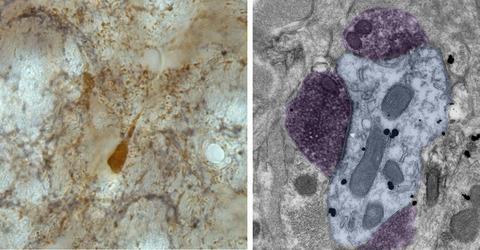当前位置:
X-MOL 学术
›
Eur. J. Neurosci.
›
论文详情
Our official English website, www.x-mol.net, welcomes your
feedback! (Note: you will need to create a separate account there.)
Glutamatergic inputs to GABAergic interneurons in the motor thalamus of control and parkinsonian monkeys
European Journal of Neuroscience ( IF 2.7 ) Pub Date : 2020-04-26 , DOI: 10.1111/ejn.14763 Daniel L Albaugh 1, 2 , Christina Huang 1 , Sherry Ye 1 , Jean-François Paré 1 , Yoland Smith 1, 2, 3
European Journal of Neuroscience ( IF 2.7 ) Pub Date : 2020-04-26 , DOI: 10.1111/ejn.14763 Daniel L Albaugh 1, 2 , Christina Huang 1 , Sherry Ye 1 , Jean-François Paré 1 , Yoland Smith 1, 2, 3
Affiliation

|
The primate ventral motor thalamus contains a large number of GABAergic interneurons of poorly understood function and anatomical connectivity. Glutamatergic inputs to these cells arise predominantly from corticothalamic (in both basal ganglia‐ and cerebellar‐receiving ventral motor thalamic territories; BGMT and CBMT, respectively) and cerebellothalamic terminals (in CBMT). In Parkinson's disease patients and animal models, neuronal activity is abnormal within both BGMT and CBMT. Historically, such motor thalamic dysregulation has been largely attributed to changes in inhibitory tone from the basal ganglia output nuclei, ignoring the potential role of other thalamic inputs in such processes, particularly within the CBMT, which is largely devoid of direct basal ganglia afferents. We have recently reported changes in the abundance and structural morphology of corticothalamic terminals in BGMT of parkinsonian monkeys. In this study, we assessed potential changes in the prevalence of cortical (vesicular glutamate transporter 1‐positive, vGluT1‐positive) and subcortical (vGluT2‐positive) glutamatergic inputs in contact with GABAergic interneurons in BGMT and CBMT of MPTP‐treated parkinsonian monkeys. Our findings revealed that interneurons represent a major target of both sets of glutamatergic terminals. In both BGMT and CBMT of control and parkinsonian monkeys, 29%–38% of total asymmetric axodendritic synapses (putative glutamatergic) were formed by vGluT1‐positive terminals and 11%–17% of total vGluT1‐positive terminals targeted dendrites of GABAergic interneurons. In CBMT, 16%–18% of asymmetric synaptic inputs on interneurons involved vGluT2‐containing terminals. No major differences in the extent of glutamatergic innervation of thalamic GABAergic interneurons were found between control and parkinsonian monkeys.
中文翻译:

对照和帕金森病猴的运动丘脑中GABA能神经元的谷氨酸能输入
灵长类动物腹侧丘脑包含大量功能和解剖连通性不清楚的GABA能神经元。这些细胞的谷氨酸能输入主要来自皮质丘脑(在基底神经节和小脑容纳腹侧运动丘脑区域;分别为BGMT和CBMT)和小脑丘脑末端(在CBMT中)。在帕金森氏病患者和动物模型中,BGMT和CBMT内的神经元活动均异常。从历史上看,这种运动性丘脑功能失调主要归因于基底神经节输出核抑制音的变化,而忽略了其他丘脑输入在此类过程中的潜在作用,特别是在CBMT内,而CBMT很大程度上缺乏直接的基底神经节传入。我们最近报道了帕金森氏猴的BGMT中皮质丘脑末端的丰度和结构形态的变化。在这项研究中,我们评估了在MPTP处理的帕金森氏猴的BGMT和CBMT中,与GABA能的中间神经元接触的皮质(囊泡谷氨酸转运蛋白1阳性,vGluT1阳性)和皮质下(vGluT2阳性)谷氨酸能输入的发生率潜在变化。我们的研究结果表明,中间神经元代表了这两种谷氨酸能末端的主要靶标。在对照和帕金森氏猴的BGMT和CBMT中,总不对称轴突突突(假定为谷氨酸能)的29%–38%是由vGluT1阳性末端形成的,而总vGluT1阳性末端的11%–17%是针对GABA能性中间神经元的树突形成的。在CBMT中,中间神经元的不对称突触输入的16%–18%涉及含vGluT2的末端。在对照和帕金森氏猴之间,丘脑GABA能神经元的谷氨酸能神经支配程度没有重大差异。
更新日期:2020-04-26
中文翻译:

对照和帕金森病猴的运动丘脑中GABA能神经元的谷氨酸能输入
灵长类动物腹侧丘脑包含大量功能和解剖连通性不清楚的GABA能神经元。这些细胞的谷氨酸能输入主要来自皮质丘脑(在基底神经节和小脑容纳腹侧运动丘脑区域;分别为BGMT和CBMT)和小脑丘脑末端(在CBMT中)。在帕金森氏病患者和动物模型中,BGMT和CBMT内的神经元活动均异常。从历史上看,这种运动性丘脑功能失调主要归因于基底神经节输出核抑制音的变化,而忽略了其他丘脑输入在此类过程中的潜在作用,特别是在CBMT内,而CBMT很大程度上缺乏直接的基底神经节传入。我们最近报道了帕金森氏猴的BGMT中皮质丘脑末端的丰度和结构形态的变化。在这项研究中,我们评估了在MPTP处理的帕金森氏猴的BGMT和CBMT中,与GABA能的中间神经元接触的皮质(囊泡谷氨酸转运蛋白1阳性,vGluT1阳性)和皮质下(vGluT2阳性)谷氨酸能输入的发生率潜在变化。我们的研究结果表明,中间神经元代表了这两种谷氨酸能末端的主要靶标。在对照和帕金森氏猴的BGMT和CBMT中,总不对称轴突突突(假定为谷氨酸能)的29%–38%是由vGluT1阳性末端形成的,而总vGluT1阳性末端的11%–17%是针对GABA能性中间神经元的树突形成的。在CBMT中,中间神经元的不对称突触输入的16%–18%涉及含vGluT2的末端。在对照和帕金森氏猴之间,丘脑GABA能神经元的谷氨酸能神经支配程度没有重大差异。











































 京公网安备 11010802027423号
京公网安备 11010802027423号